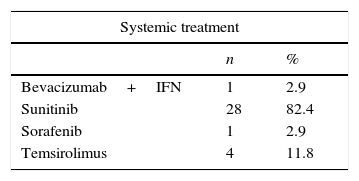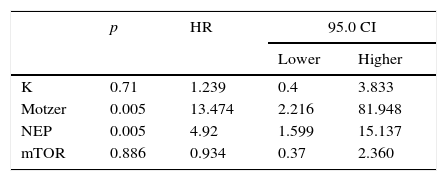Systemic treatment for metastatic renal cell carcinoma (mRCC) has changed with the new therapies, and it is not clear if nephrectomy (NEP) has a survival benefit in this kind of patients.
ObjectiveTo investigate if NEP associated to systemic treatment improves overall survival (OS) and progression-free survival (PFS).
Material and methodsA retrospective, observational, descriptive study of 45 patients with diagnosis of mRCC between 2006 and 2014. Advanced cases with only palliative care were excluded, also patients with solitary metastasis who were managed with surgical resection.
ResultsFinally 34 patients were treated with systemic treatment. Twenty-six also with surgery associated. Seventy percent were intermediate/low risk at the Motzer classification and >80% Karnofsky performance status. PFS was 7m. NEP improves PFS (10 vs. 4m). High risk Motzer decreased PFS (p<0.001). The OS was 11.5m. Patients with Karnofsky performance status >80, intermediate or low risk Motzer treated with NEP and mTOR as second line treatment, increased the OS (14 vs. 3m, p=0.0001; 14 vs. 6m, p=0.001; and 9 vs. 5m, p=0.003, respectively). In the multivariate analysis only NEP (p=0.006; HR 4.5) and intermediate/low risk at the Motzer classification (p=0.020; HR 8.9) demonstrated significant improvement in OS.
ConclusionsPatients treated with NEP associated to systemic treatment and with an intermediate/low risk in the Motzer classification had a better PFS and OS. The OS also improves in patients treated with mTOR in second line, and Karnofsky performance status >80% in the univariate study, but not in the multivariable one.
El tratamiento sistémico del carcinoma de células renales metastásico (CCRm) ha cambiado con la aparición de nuevas terapias, planteándose la utilidad de la nefrectomía (NFT) en estos pacientes.
ObjetivoAnalizar si la NFT asociada a tratamiento sistémico prolonga el tiempo libre de progresión (TLP) y la supervivencia global (SG).
Material y métodosEstudio descriptivo restrospectivo de 45 pacientes con CCRm entre 2006–2014. Se descartaron casos avanzados con tratamiento paliativo o con metástasis únicas tratados exclusivamente con cirugía.
ResultadosFinalmente 34 pacientes fueron tratados con tratamiento sistémico. En 26 se empleó además cirugía. El 70% presentaban riesgo intermedio en la clasificación de Motzer y un índice de Karnofsky>80%. El TLP fue de 7m, encontrándose diferencias significativas entre los grupos con y sin NFT (10 vs. 4m). Hubo menor TLP en pacientes con Motzer alto (p<0.0001). La SG fue de 11.5m. Se encontró mayor SG en pacientes con índice de Karnofsky>80 (13 vs. 5m; p=0.005), Motzer medio/bajo (14 vs. 3m; p=0.0001), NFT (14 vs. 6m; p=0.001) y tratamiento inhibidor mTOR en segunda línea (9 vs. 5m; p=0.003). En el análisis multivariable solo la NFT (p=0.006; HR 4.5) y un Motzer medio/bajo demostraron una mayor supervivencia (p=0.020; HR 8.9).
ConclusionesEl TLP y la SG aumentaron significativamente en pacientes con NFT asociada, en CCRm de riesgo intermedio/bajo (Motzer). La SG además aumentó en pacientes tratados con mTOR de segunda línea y en pacientes con índice de Karnofsky>80% en el análisis univariable, no pudiendo demostrarlo en el estudio multivariable.










